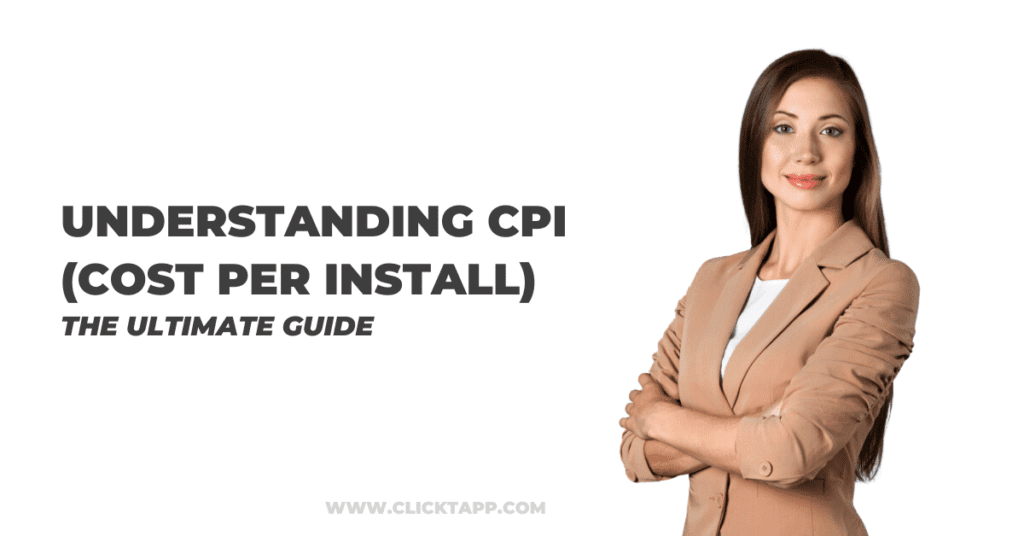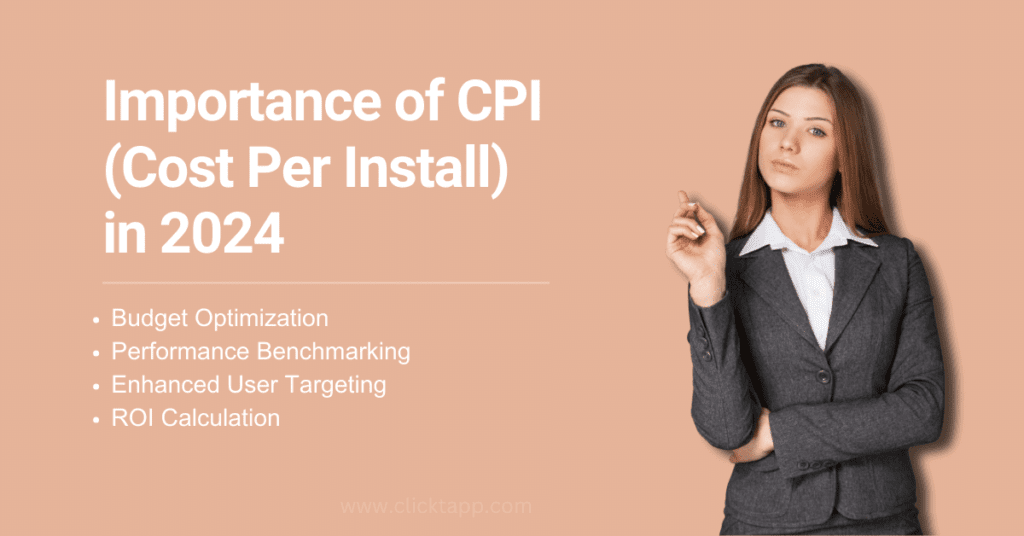CPI (Cost Per Install) in 2024: The Ultimate Guide
Understanding CPI (Cost Per Install)
CPI (Cost Per Install) in 2024 is vital for mobile app marketing. This metric reveals the cost of each app installed from a campaign. It allows advertisers to track their returns. For instance, $2 for 100 installs means a $200 campaign cost. Advertisers pay a fixed fee for each install via an ad click. This makes CPI campaigns popular in app stores and mobile ad networks. They boost user growth. Consider “Epic Quest,” a top mobile game. It paid $1.50 per install and gained 10,000 new users in a week. Factors like audience targeting and ad creativity affect CPI. Market competition and app appeal also play a role. A fitness app with high appeal can increase CPI by attracting users from other apps. CPI campaigns need regular fine-tuning to cut costs and improve conversions. Advertisers watch CPI to enhance their strategies and achieve better results.

Importance of CPI (Cost Per Install) in 2024
CPI, or Cost Per Install, is key in mobile ads. It shows the cost for each app download. Advertisers pay just for installs. For instance, a gaming app ad can focus on players. The ad budget is used only for successful downloads. This stops spending on ads that don’t lead to installs. It uses budgets wisely.
1. Budget Optimization
CPI has a key benefit: precise budgeting. For example, a gaming company can spend $10,000 to launch an app. They’ll know how many installs to expect. This helps them plan and improve marketing. So, their return on investment (ROI) is higher. Let’s say they set a $2 CPI. They would get 5,000 installs. This often leads to more purchases and subscriptions. Good budgeting allows advertisers to make better choices. It also stops them from spending too much and helps manage resources.
2. Performance-Based Marketing:
CPI is a model that pays for results. It’s perfect for marketing strategies that guarantee success. Marketers today count on data to drive their choices. By 2024, businesses will want clear signs of how well their campaigns are doing. CPI will become more popular because it shows clear benefits. Advertisers can see installs and sales by using CPI. This knowledge leads to smarter choices. CPI shows how ad spending works, unlike old methods. Brands that adopt CPI can strengthen their strategies. They also can lower waste and better share resources.
3. Enhanced User Targeting
Modern CPI campaigns have revamped advertising. They now use better targeting and optimization. This means we analyze the audience carefully. We also identify the right groups and behaviors. Then, we tailor campaigns to suit the best audience. This raises app installs and user activity. For instance, a gaming app can use machine learning to target fans of similar games. It shows them tailored ads, highlighting its unique features. By improving their strategies, advertisers increase their profits. They also achieve results in the tough app market.
4. ROI Calculation
CPI is instrumental in calculating the return on investment for app-related advertising campaigns. By weighing the cost per install against the user lifetime value (LTV), businesses can gauge the long-term profitability of their user acquisition efforts.

Campaign Launch
Kick off your ad campaign. Then, check its progress on the dashboard. This step is key. It shows how well your ads are doing. You can see what needs fixing and improve your strategy. Keep an eye on key metrics. These include click-through rates, conversion rates, and return on investment. Then, tweak your targeting, ad content, and budget. For example, if an ad gets low engagement, replace it quickly. You can pause it to save money. Check the dashboard often. This helps you adapt to market or behavior changes. It keeps your campaign effective.
How CPI (Cost Per Install) Works in 2024
Pick a popular ad platform for cost-per-install (CPI) campaigns. With CPI, you pay each time someone installs your app or game from an ad. Google Ads reaches many people and has strong targeting. Facebook Ads gives great insights and helps you make custom ads. For mobile games, use Unity Ads and Chartboost. First, check their traffic quality. Then, look at the ad types and tracking. The right platform can boost your CPI campaigns and profits.
User Interaction
Potential users interact with these ads. They could be banner ads on websites or video ads on social media.
Define Target Audience
Identify your target audience’s age, interests, and behaviors. This allows you to tailor your campaign. Aim to reach those most likely to install the app.
App Installation
Attribution tools work like detectives. They can tell when an app is installed and which ad caused the download. For instance, a user might see an ad on social media. They click the ad out of curiosity and install the app. Adjust, AppsFlyer, and Branch keep an eye on ad performance. Adjust helps a gaming app see which Facebook or Instagram ads bring in the most downloads. This helps developers improve their strategy. They can spend more on ads that work and stop funding the ones that don’t.
Data Analysis
Marketers check campaign data to see how well they did. They look at two important metrics: downloads and ad spending. After that, they figure out the cost per install (CPI). It’s a key measure of success. For instance, with 1,000 installs and $1,500 in ads, the cost per install (CPI) is $1.50. This means each download costs $1.50. This analysis helps them improve their strategy. It also shows them how to use resources wisely in future campaigns. The goal is to increase profit.
Optimization
Improving ads is vital for success. It’s like fine-tuning a race car. Advertisers use data to improve targeting, boost creativity, and change bids. This allows brands to connect more with their audience. They can track when customers shop the most, like during peak times. So, it adjusts ad placements and bids. The result? Advertisers need to focus on better targeting, engaging customers, and increasing sales. They also have to keep an eye on their strategies and adjust them as needed. It keeps them ahead and makes a profit.

Navigating Challenges and Best Practices in 2024
The campaign can improve by changing CPI and other metrics. This might mean updating ads, exploring new audiences, or shifting budgets. It’s vital to follow best practices to deal with challenges.
- Diversify Advertising Platforms: Don’t rely only on Google and Facebook. Also, look for new platforms where your target audience is active.
- Embrace Creativity in Ad Content: By 2024, the digital world had grown very competitive. Many app categories were now saturated. The CPI metric has become more important than ever. Now, let’s explore why.
- Leverage Advanced Analytics: Use machine learning and AI tools. They can analyze campaigns and user behavior. This refines campaign targeting and optimization for exact results.
- Prioritize User Privacy: Follow privacy rules. Build trust by being open about data use. In exchange for their information, offer value.
The Future of CPI
Integration with AI and Machine Learning
AI and machine learning are shaping CPI campaigns. They use predictive analytics to target the right audience. This cuts waste and increases returns. Facebook leverages AI to better its ad placements. As a result, engagement and sales have gone up. AI and machine learning allow us to react fast to market changes. Coca-Cola shows this well. In 2018, it revamped its marketing for the FIFA World Cup. This led to a 15% boost in sales.
Cross-Platform Campaigns
Mobile and digital platforms are merging at a fast pace. This change impacts Cost Per Install (CPI) campaigns. These campaigns can easily connect to multiple devices and outlets. This unified approach draws in users from all sectors. A gaming company can reach users on phones, tablets, and laptops. This ensures a smooth experience with the brand. It helps companies market better and raise their conversion rates. Devices and channels are merging now. Now, a good CPI strategy is vital to remain competitive.
Creative Development
Create appealing ads. They should include banners, videos, and interactive ads. They will boost app downloads. Make ads that catch the eye, just like the well-known Coca-Cola billboard. They need to connect with your target audience. This is much like Nike’s “Just Do It” campaign. It motivates athletes. Use bold visuals, good stories, and clear calls to action. This will grab users’ attention and push them to act.
Conclusion
CPI is key in mobile app marketing. It raises precision, performance, and growth. Apps that capture CPI in 2024 can succeed. Advertisers must focus on targeted campaigns. They also need to optimize frequently and try new technology. This approach leads to steady user growth.
Here are some important FAQs about Cost Per Install(CPI)
What is the Cost Per Install (CPI)?
CPI is a metric in mobile app marketing. It measures the cost an advertiser pays each time a user installs their app via a paid ad.
How is CPI calculated?
CPI is the total ad spend divided by the installs from the ads. The formula is:
CPI = Total Number of Installs / Total Ad Spend
Why is CPI important?
CPI helps advertisers see how well their app marketing spend is. It measures ROI and fine-tunes ad budgets.
What factors influence CPI rates?
CPI rates depend on several factors. These are the audience’s location, the platform (iOS or Android), the app type, the ad network, and the time of year.
What is a good CPI rate?
A good CPI rate varies by industry and region. Lower CPI rates are usually a good sign. They show a cheaper way to gain users. The average cost per install (CPI) ranges from $1 to $5. This depends on different factors.
How does CPI differ between iOS and Android?
CPI rates for iOS are usually higher than for Android. This is because iOS users are seen as more affluent and more likely to spend on in-app purchases.
What are the advantages of using CPI as a pricing model?
CPI is safe for advertisers. They pay only when a user installs the app. This links ad spending directly to gaining users, making it a performance-based model.
What are some best practices for optimizing CPI campaigns?
Best practices are to target the right audience and use top ads. Test different ad formats. Enhance the user acquisition funnel. Then, look at the campaign data and adjust as needed.
How does CPI compare to other pricing models, like CPM or CPC?
CPI stands for Cost Per Install. It targets app installs, unlike CPM (Cost Per Mille) or CPC (Cost Per Click). CPM costs are based on every thousand impressions. CPC costs are based on each click, even if the app isn’t installed. CPI charges you only when the app is installed successfully.
What are some common challenges with CPI campaigns?
A common challenge is high competition, which drives up CPI rates. It’s hard to track and attribute installs. We also need to confirm that new users will engage with the app after they install it.


Pingback: CPM (Cost Per Mile) in 2024 - Clicktapp
Pingback: CPR In Affiliate Marketing: A Comprehensive Guide - Clicktapp
Pingback: Digital Marketing Trends in 2025: The Future of Online Marketing - Clicktapp